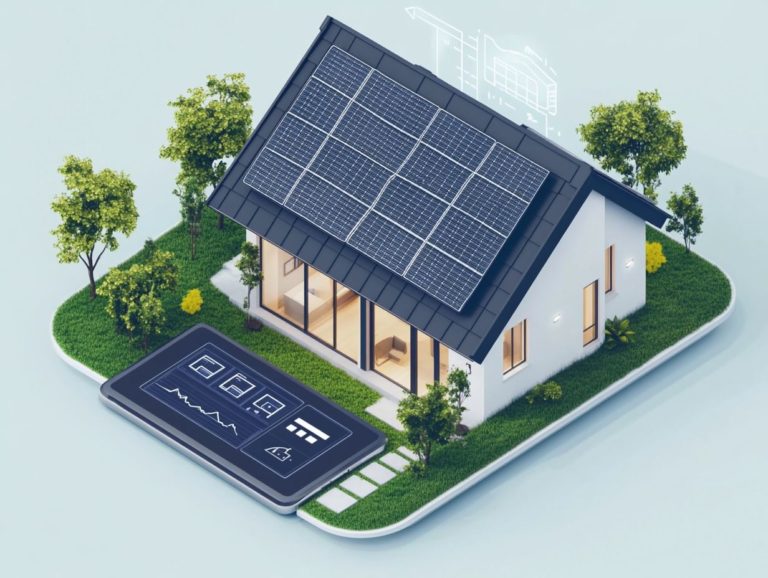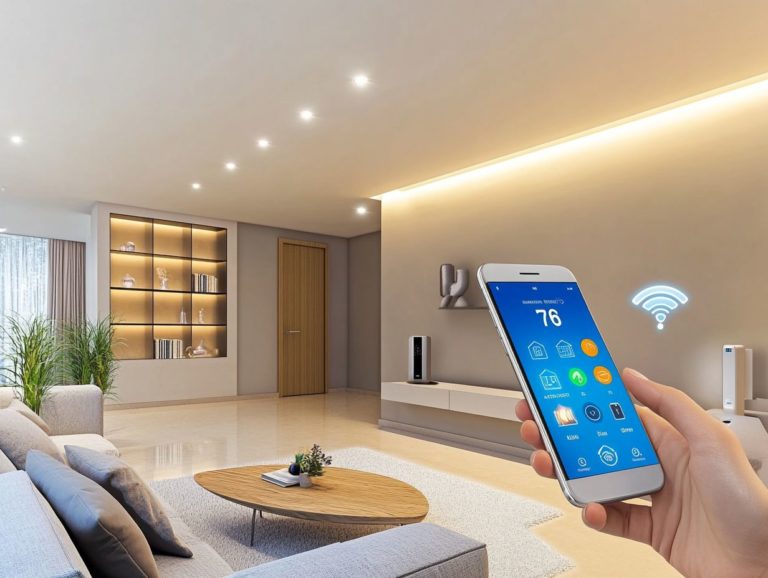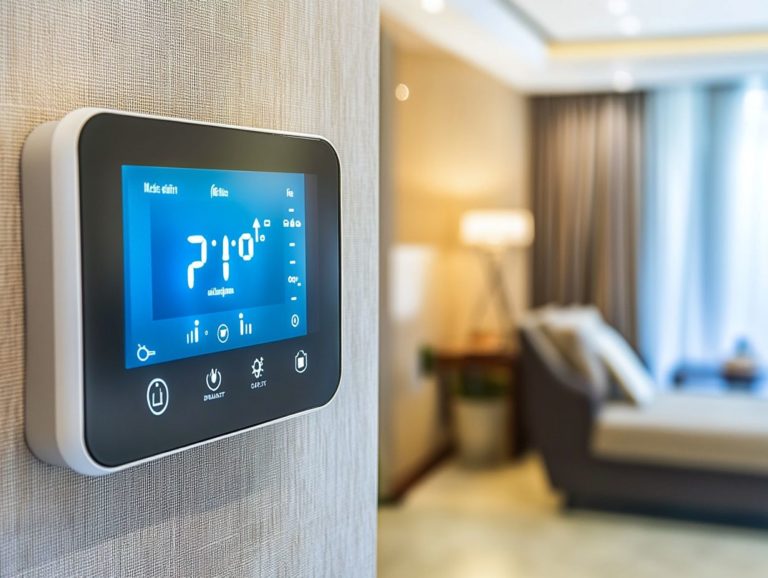Creating an Energy-Efficient Smart Home Ecosystem
In today’s world, the call for sustainability resonates louder than ever. Transforming your living space into an energy-efficient smart home is an exceptional way for you to make a meaningful contribution.
Not only does it help reduce energy consumption and lower your utility bills, but it also enhances the convenience of your daily life.
This article delves into the essential components of an energy-efficient smart home, covering everything from smart thermostats to intelligent appliances. It offers valuable insights on selecting the right devices, integrating them seamlessly, and maximizing your energy savings.
Discover how to craft a customized, eco-friendly sanctuary that not only benefits your wallet but also nurtures the planet.
Contents
- Key Takeaways:
- The Benefits of an Energy-Efficient Smart Home
- Key Components of an Energy-Efficient Smart Home
- Smart Thermostats
- Smart Lighting
- Smart Appliances
- Choosing the Right Smart Home Devices
- Factors to Consider
- Summary
- Integrating and Automating Your Smart Home Ecosystem
- Monitoring and Managing Energy Usage
- Tips for Maintaining an Energy-Efficient Smart Home
- Frequently Asked Questions
- What is an energy-efficient smart home ecosystem?
- How can I create an energy-efficient smart home ecosystem?
- What are the benefits of creating an energy-efficient smart home ecosystem?
- Do I need to be tech-savvy to create an energy-efficient smart home ecosystem?
- What type of devices can be included in an energy-efficient smart home ecosystem?
- Will creating an energy-efficient smart home ecosystem save me money?
Key Takeaways:

- An energy-efficient smart home can significantly reduce energy consumption and costs.
- The key components include smart thermostats, lighting, and appliances.
- When choosing smart home devices, consider compatibility, energy efficiency ratings, and customization options.
The Benefits of an Energy-Efficient Smart Home
An energy-efficient smart home harnesses the latest Internet of Things (IoT) technology and smart devices to optimize your energy consumption. This significantly reduces your utility costs while helping you achieve a lower carbon footprint.
Integrating smart appliances, heating and cooling systems, and ENERGY STAR-rated products enhances comfort and sustainability in your daily life. Embrace this modern lifestyle and enjoy a more sustainable future!
As you explore the advantages, you’ll uncover how energy efficiency transforms your living spaces into intelligent ecosystems that prioritize both the environment and your personal well-being.
Reducing Energy Consumption and Costs
Implementing smart devices in your home can lead to impressive reductions in energy consumption and costs. This makes it a savvy investment for homeowners who care about the environment.
These innovations add convenience to your life and enhance your energy management efficiency. Smart plugs, for example, monitor energy usage and automate appliance schedules, ensuring that devices only draw power when necessary.
According to data from the U.S. Department of Energy, homes equipped with smart thermostats like Nest or ecobee can save an average of 10-12% on heating and cooling costs each year.
In one compelling case study, a family utilizing an ecobee thermostat reported over $200 in annual savings. They significantly reduced their utility bills while minimizing their carbon footprint. Embracing these technologies isn t just a smart move; it s a step toward a more sustainable future.
Key Components of an Energy-Efficient Smart Home
To create an energy-efficient smart home, incorporate essential components that work harmoniously to optimize energy usage and minimize waste. Key elements such as advanced smart appliances, smart thermostats, and smart lighting systems all driven by IoT technology are vital in this endeavor.
By integrating these components, you can ensure that your heating and cooling systems operate at peak performance. Utilize ENERGY STAR-rated products and take advantage of automated settings that adjust energy consumption based on real-time data.
This modern approach elevates convenience and comfort while leading to significant energy savings and environmental benefits.
Smart Thermostats
Discover how smart thermostats can transform your energy efficiency. Smart thermostats, like those from Nest and ecobee, are critical tools for enhancing energy efficiency in your home by expertly managing heating and cooling.
These amazing devices use smart technology to adapt to your lifestyle. They continuously collect data and automatically adjust settings based on your habits and preferences. With handy scheduling features, you can set specific heating and cooling times that fit seamlessly into your daily routine.
Thanks to their impressive learning capabilities, these smart thermostats adapt over time, ensuring maximum comfort while minimizing energy use. You can also control settings remotely, allowing adjustments from anywhere using your smartphone app.
Statistics reveal that using these devices properly can lead to energy savings of up to 30%. This underscores their significance in promoting eco-friendly living and cost efficiency.
Smart Lighting
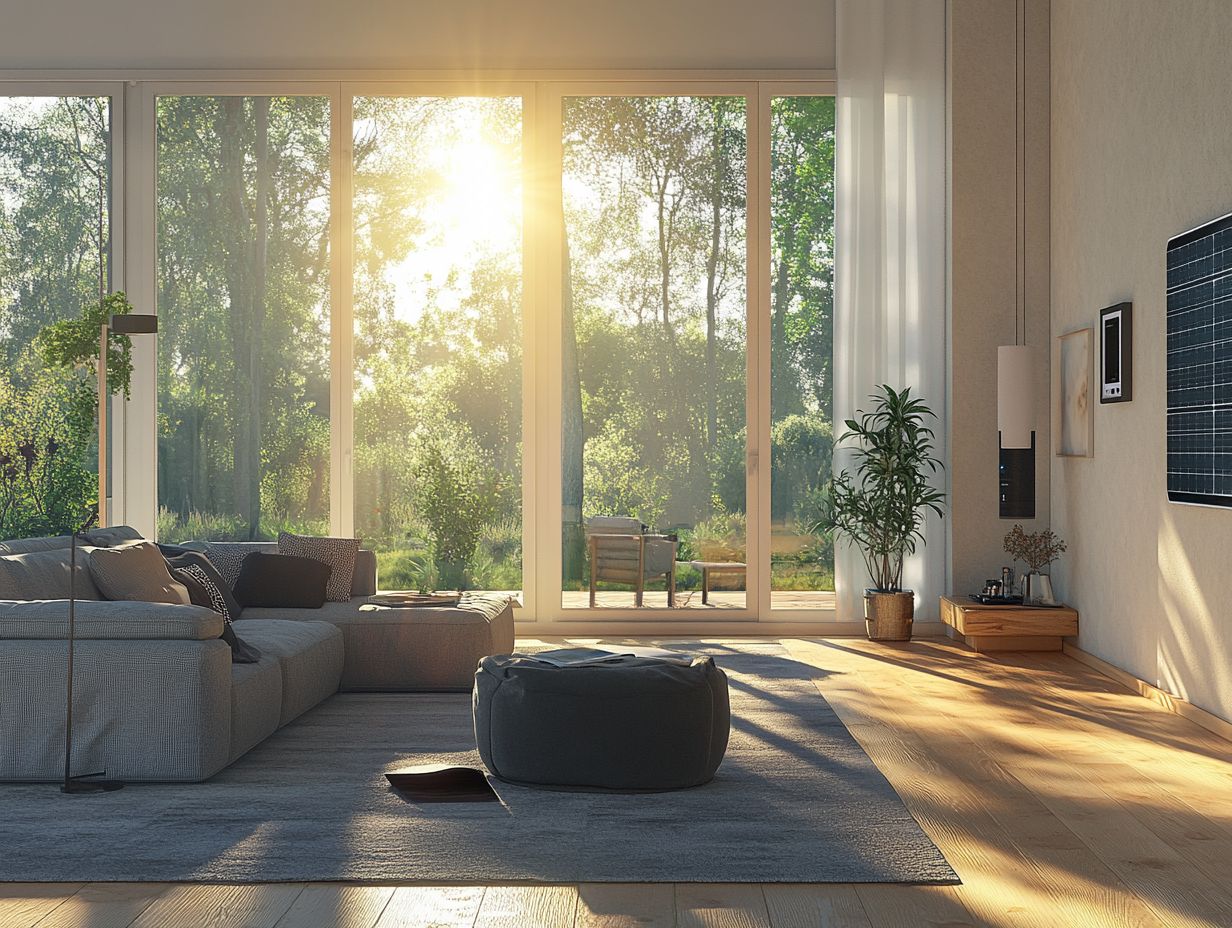
Explore how smart lighting can enhance your energy efficiency. Smart lighting solutions, such as LED bulbs and programmable systems, elevate energy efficiency in your modern home by giving you precise control over your lighting usage.
These intelligent systems help reduce energy consumption and allow you to create customized lighting schedules that align with your daily routines. For example, when connected to smart hubs like SmartThings Energy, you can manage your lights seamlessly alongside other devices, ensuring your smart home works in harmony. Utilizing the effective use of smart sensors for energy savings can enhance this experience even further.
With compatibility across various smart technologies, you can adjust your lighting from virtually anywhere, maximizing convenience and contributing to a sustainable lifestyle. To make the best choices, consider how to choose energy-efficient smart devices. Ultimately, smart lighting creates an environment that balances practicality with impressive energy savings.
Smart Appliances
Investing in smart appliances enhances your home automation experience and leads to significant energy savings through advanced technology and ENERGY STAR ratings. These innovative devices, like the latest Samsung refrigerators, allow you to monitor your food inventory effortlessly and receive alerts for expiration dates, minimizing waste.
Smart washing machines equipped with technology that learns your habits automatically adjust water levels and wash cycles, optimizing both electricity and water usage. Brands like Carrier and Bryant have further elevated this experience by integrating smart thermostats that manage heating and cooling autonomously, relying on real-time weather data and household activity.
With these advancements, making eco-friendly choices has never been easier, allowing you to enjoy the luxurious convenience of modern living.
Choosing the Right Smart Home Devices
Choosing the right smart home devices is essential for maximizing energy efficiency and enhancing your living space’s functionality. Consider factors such as compatibility with your existing systems, energy ratings, and the potential for integration with smart hubs like SmartThings Energy.
By carefully evaluating these criteria, you can select devices that fulfill your specific requirements while fostering long-term energy savings through saving energy with smart home devices and enhancing your home automation. This thoughtful approach guarantees that each smart device operates seamlessly within your smart home ecosystem, optimizing both convenience and efficiency.
Factors to Consider
When selecting smart home devices, consider important factors such as energy efficiency, compatibility, and the potential for automation.
Focusing on energy efficiency lowers utility bills and makes a positive impact on environmental sustainability. Ensuring device compatibility with your current systems allows for seamless integration, making management a breeze. For insights on the future of home energy management with smart tech, technologies like Zigbee and Z-Wave enhance device interoperability, enabling you to connect a diverse array of products from various manufacturers.
Embracing automation provides unmatched convenience. Imagine setting schedules and routines that optimize your daily tasks, like automatically adjusting your lighting or thermostat based on occupancy. It s all about making your life easier and more efficient.
Summary
In conclusion, integrating smart home technology can significantly improve your energy efficiency and overall convenience. By selecting the right devices and harnessing their capabilities, you can enjoy a more eco-friendly lifestyle while simplifying your daily routines. Explore smart devices today and start saving energy!
Integrating and Automating Your Smart Home Ecosystem
Integrating and automating your smart home ecosystem is a crucial step in elevating energy efficiency. It helps craft a living environment that perfectly aligns with your lifestyle.
By utilizing a smart hub, a device that connects and controls all your smart gadgets, you can synchronize various devices. You can also establish customized schedules that optimize energy consumption based on real-time usage patterns, potentially reducing costs as outlined in the impact of smart home solutions on energy bills.
This level of automation simplifies your daily routines. It enables you to monitor your energy usage effectively, leading to significant savings and enhanced comfort.
Whether you’re adjusting HVAC systems or controlling smart lighting, the interconnected nature of these devices creates a truly intelligent home experience. For those interested in enhancing their setup, integrating smart tech with existing home systems is a great way to tailor it just for you.
Creating Customized Schedules and Settings

Creating customized schedules and settings within your smart home ecosystem enables you to enhance energy monitoring. This ensures you optimize usage throughout the day.
By programming your thermostats to lower the temperature at night or setting your lighting to turn off when the house is empty, you can significantly reduce your energy consumption. These personalized settings lead to lower utility bills and foster a living environment that aligns with your routines.
For example, imagine scheduling your lights to dim during movie nights. This not only elevates the cinematic experience but also extends the lifespan of your bulbs.
Successful implementations, especially in homes with smart meters, have shown up to a 30% reduction in energy costs. This illustrates the undeniable benefits of strategic scheduling.
Monitoring and Managing Energy Usage
Monitoring and managing energy usage is crucial for reaping the full rewards of a smart home. This enables you to make informed decisions about your energy consumption.
With smart home apps and IoT technology, you can track your energy usage in real time. You can pinpoint inefficiencies and adjust your habits to unlock meaningful energy savings.
By harnessing data from your various smart devices, you gain a comprehensive understanding of your total energy use. You can then take actionable steps to reduce it.
This proactive approach boosts your comfort and makes your home more environmentally friendly.
Using Smart Home Apps and Tools
Smart home apps and tools serve as invaluable resources for monitoring energy usage and automating devices throughout your home.
These applications provide a centralized platform to track your energy consumption in real-time. This makes it easier to make informed decisions about your usage patterns.
Many of these tools integrate seamlessly with a wide range of smart devices, including thermostats, lights, and security systems. This gives you the flexibility to customize your home automation experience.
User feedback consistently highlights the convenience of setting schedules that streamline daily tasks. These apps also work well with voice assistants like Alexa or Google Assistant, making energy management intuitive and efficient.
Tips for Maintaining an Energy-Efficient Smart Home
Maintaining an energy-efficient smart home requires attention to regular maintenance and upgrades. This ensures optimal performance and sustained energy savings.
By periodically checking the functionality of your smart appliances and updating their software, you can prevent inefficiencies. These may otherwise lead to increased energy consumption.
Investing in upgrades for older HVAC systems can further enhance your home’s energy efficiency. These proactive measures prolong the lifespan of your devices and contribute to a greener, more sustainable living environment.
Start using these tools today and watch your energy consumption drop!
Regular Maintenance and Upgrades
Regular maintenance and timely upgrades of your smart devices are essential for your energy-efficient smart home to operate at its peak.
This includes tasks such as cleaning your devices to prevent dust buildup and performing software updates to enhance functionality and security. Troubleshooting any glitches that arise is also important. By regularly inspecting smart connections and operational features, you can proactively address issues that could interfere with efficiency.
Upgrading older smart devices enhances performance and reduces energy consumption. Newer models are engineered with advanced energy-saving technologies.
Investing in these updates ensures your equipment runs smoothly and sustainably. Ultimately, this creates a more cost-effective and environmentally friendly living space.
Maximizing Energy Savings
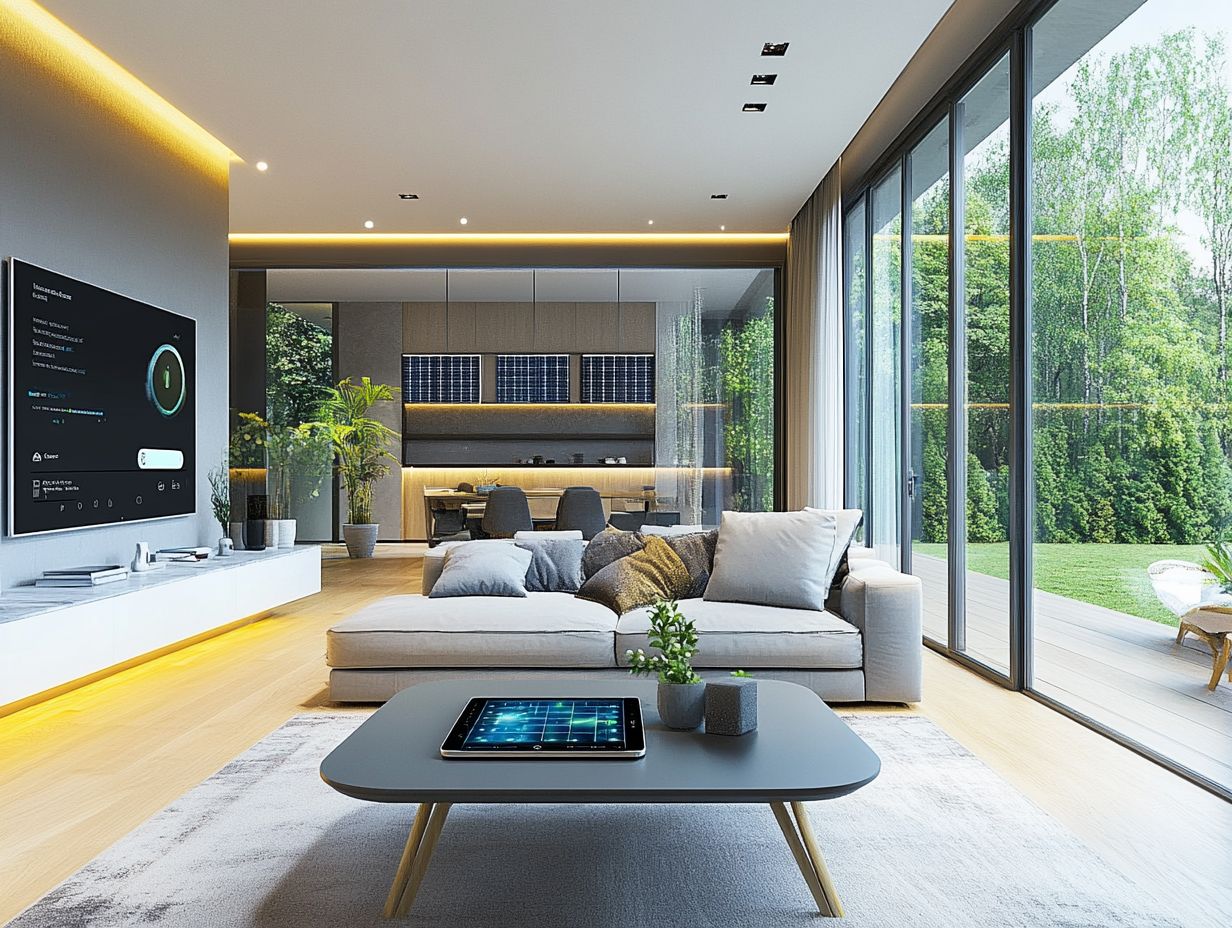
Maximizing energy savings in your smart home requires varied methods that focus on improving efficiency.
By integrating energy monitoring tools, you gain real-time insights into your energy consumption patterns. This allows you to pinpoint peak usage times and adjust accordingly. For more detailed strategies, check out how to optimize energy use with smart home tech. Optimizing device settings enhances efficiency, enabling smart appliances to operate during off-peak hours when energy costs are lower.
Implementing automation through your smart home systems, such as scheduling lights and smart thermostats, can lead to significant reductions in energy waste. Many households have shared impressive success stories, often cutting their monthly bills by 30% simply by adopting these energy-saving strategies.
Frequently Asked Questions
What is an energy-efficient smart home ecosystem?
An energy-efficient smart home ecosystem refers to connected devices and systems that work together to reduce energy consumption while providing convenience and comfort for the homeowner.
How can I create an energy-efficient smart home ecosystem?
To create an energy-efficient smart home ecosystem, assess your current energy usage first. Identify areas for improvement, then invest in energy-efficient appliances and devices, install a smart thermostat, and incorporate renewable energy sources like solar panels and ENERGY STAR rated products.
What are the benefits of creating an energy-efficient smart home ecosystem?
Creating an energy-efficient smart home ecosystem offers several benefits: save money on energy bills, reduce your carbon footprint, increase comfort, and potentially boost your home’s value.
Do I need to be tech-savvy to create an energy-efficient smart home ecosystem?
No, you do not need to be tech-savvy. Many smart home devices are designed for easy installation and use. Various resources and professionals are available to assist you.
What type of devices can be included in an energy-efficient smart home ecosystem?
Devices such as smart thermostats, LED light bulbs, motion sensors, smart plugs, and energy monitoring systems can be included. These devices help control and optimize energy usage, contributing to a reduced carbon footprint and a more sustainable lifestyle.
Will creating an energy-efficient smart home ecosystem save me money?
Yes, creating an energy-efficient smart home ecosystem can save you money long-term. By reducing energy consumption, you can lower your energy bills and may qualify for tax incentives or rebates. Moreover, investing in energy-efficient devices can increase your home’s value.




